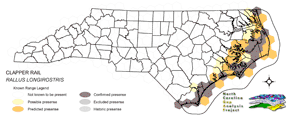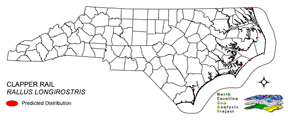
| Taxa: |
| Order: |
| Family: |
| Aves |
| Gruiformes |
| Rallidae |
| NatureServe Global Rank: |
| NatureServe State (NC) Rank: |
| G5 |
| S5 |
| Federal Status: |
| NC State Status: |
| --- |
| --- |


| Land Unit |
| US Fish & Wildlife Service |
| US Forest Service |
| US National Park Service |
| US Department of Defense |
| NC State Parks |
| NC University System |
| NC Wildlife Res. Com. |
| NC Forest Service |
| NC Div. of Coastal Mgmt. |
| Local Governments |
| Non-Governmental Org. |
| Other Public Lands |
| Private Lands |
| GAP Status 1-2 |
| All Protected Lands |
| Statewide |
| Hectares |
| 15,556.59 |
| 160.02 |
| 6,739.83 |
| 5,924.79 |
| 1,167.66 |
| 0.00 |
| 4,150.08 |
| 0.00 |
| 1,237.05 |
| 3.33 |
| 1,949.04 |
| 34.83 |
| 57,294.27 |
| 26,932.23 |
| 36,379.89 |
| 94,217.49 |
| Acres |
| 38,441.16 |
| 395.42 |
| 16,654.48 |
| 14,640.47 |
| 2,885.35 |
| 0.00 |
| 10,255.07 |
| 0.00 |
| 3,056.82 |
| 8.23 |
| 4,816.18 |
| 86.07 |
| 141,577.20 |
| 66,550.98 |
| 89,896.65 |
| 232,816.44 |
| % of Dist. on |
| Prot. Lands |
| 42.8 % |
| 0.4 % |
| 17.0 % |
| 16.3 % |
| 3.2 % |
| 0.0 % |
| 11.4 % |
| 0.0 % |
| 3.4 % |
| 5.4 % |
| 5.4 % |
| < 0.1 % |
| < 0.1 % |
| 74.0 % |
| ----- |
| ----- |
| % of Dist. on |
| All Lands |
| 16.5 % |
| 0.2 % |
| 7.2 % |
| 6.3 % |
| 1.2 % |
| 0.0 % |
| 4.4 % |
| 0.0 % |
| 1.3 % |
| < 0.1 % |
| 2.1 % |
| < 0.1 % |
| 60.8 % |
| 28.6 % |
| ----- |
| ----- |
|
The subspecies waynei (Taylor 1998) is common along the coast (Fussell 1994, Fussell and Lyons 1990), and is only rarely seen inland during migration (Potter et al. 1980). Nest site is located in a drier, slightly elevated area of the marsh not flooded by the tide (Harrison 1975). Nest is built on the ground in a clump of grass or attached to a plant over shallow water (Potter et al. 1980). NATURE SERVE GLOBAL HABITAT COMMENTS: Salt and brackish marshes and mangrove swamps, locally (mostly in lower Colorado River Valley) in freshwater marshes where associated with dense vegetation and/or abundant crayfish (AOU 1983). Nests on the ground in growing or dead herbage or under a small bush, or in places raised above the ground in a grass tuft or clump of rushes (Harrison 1978), among mangrove roots. Nests on the highest, driest place in the marsh (Terres 1980). |
| Code | Name | Description | NC Natural Heritage Program Equivalent |
| 3 | Tidal Marsh | Fresh and brackish tidal marshes, including cord grass, wild rice, sawgrass and needlerush alliances. | Brackish Marsh, Interdune pond, Maritime wet grassland |
| 124 | Maritime Scrubs and Tidal Shrublands | Coastal shrubs including wax-myrtle, swamp rose, alder, yaupon, and greenbriar. | Maritime Shrubs, Salt Shrub |
| 372 | Interdune Herbaceous Wetlands | Dune swales with permanently flooded to intermittently exposed hydrology. Species composition depends on salinity and can include cut grass, spike-rush, mosquito fern, and hornwort. | Interdune Pond, Maritime Wet Grasslands |
| 380 | Coastal Plain Fresh Water Emergent | Emergent vegetation in fresh water seepage bogs, ponds and riverbeds of the coastal plain. Includes alliances dominated by sedges, eelgrass, as well as cane found in unforested cane-brakes. | Small Depression Pond, Sandhill Seep, Floodplain Pool, Unforested Floodplain Canebrake, Riverscour Prairies, Vernal Pools |
| 173 | Coastal Plain Riverbank Shrubs | Shrub dominated riverbanks, commonly dominated by willows and/or alders. | Sand and Mud Bar |
|
Crawford, R. L., S. L. Olson, and W. K. Taylor. 1983. Winter distribution of subspecies of clapper rails (RALLUS LONGIROSTRIS) in Florida with evidence for long-distance andoverland movements. Auk 100:198-200.
Eddleman, W. R., F. L. Knopf, B. Meanley, F. A. Reid, and R. Zembal. 1988. Conservation of North American rallids. Wilson Bulletin 100:458-475. Bent, A. C. 1926. Life histories of North American marsh birds. U.S. National Museum Bulletin No. 135. [reprint. 1963. Dover Publications, Inc., New York, New York]. Fussell, J. III and M. Lyons. 1990. Birds of the Outer Banks [pamphlet]. Eastern National Parks and Monument Association Coastal Wildlife Refuge Society. Fussell, J.O. III. 1994. A birderís guide to coastal North Carolina. Chapel Hill and London: The University of North Carolina Press. Zembal, R., and J. M. Fancher. 1988. Foraging behavior and foods of the light-footed clapper rail. Condor 90:959-962. Taylor, B. 1998. Rails. A guide to the rails, crakes, gallinules, and coots of the world. New Haven and London: Yale University Press. 600p. Zembal, R., B. M. Massey, and J. M. Fancher. 1989. Movements and activity patterns of the light-footed clapper rail. J. Wildlife Management 53:39-42. Manser, P. 1990. The clapper rail (RALLUS LONGIROSTRIS). Gosse Bird Club Broadsheet 55:9-10. Harrison, H.H. 1975. A field guide to bird's nests in the U.S. east of the Mississippi River. Houghton Mifflin Company, Boston, Massachusetts. 257 p. Ripley, S.D. 1977. Rails of the world. M.F. Feheley Publishers, Ltd., Toronto. 406 pp. Harrison, C. 1978. A field guide to the nests, eggs and nestlings of North American birds. Collins, Cleveland, Ohio. Harrison, H.H. 1979. A field guide to western birds' nests. Houghton Mifflin Company, Boston. 279 pp. Anderson, B. W., and R. D. Ohmart. 1985. Habitat use by clapper rails in the lower Colorado River valley. Condor 87:116-126. Potter, E. F., J. F. Parnell, and R. P. Teulings. 1980. Birds of the Carolinas. Univ. North Carolina Press, Chapel Hill. 408 pp. Terres, J.K. 1980. The Audubon Society encyclopedia of North American birds. Alfred A. Knopf, New York. American Ornithologists' Union (AOU), Committee on Classification and Nomenclature. 1983. Check-list of North American Birds. Sixth Edition. American Ornithologists' Union, Allen Press, Inc., Lawrence, Kansas. Raffaele, H.A. 1983. A guide to the birds of Puerto Rico and the Virgin Islands. Fondo Educativo Interamericano, San Juan, Puerto Rico. 255 pp. Meanley, B. 1985. The marsh hen:a natural history of the clapper rail of the Atlantic coast salt marsh. Tidewater Publishers, Centreville, MD. 123 pp. Avise, J.C., and R.M. Zink. 1988. Molecular genetic divergence between avian sibling species:king and clapper rails, long-billed and short-billed dowitchers, boat-tailed and great-tailed grackles, and tufted and black-crested titmice. Auk 105:516-528. |
For more information please contact them at:
NC-GAP Analysis Project
Dept. of Zoology, NCSU
Campus Box 7617
Raleigh, NC 27695-7617
(919) 513-2853
www.basic.ncsu.edu/ncgap